table FORD FIESTA 2007 User Guide
[x] Cancel search | Manufacturer: FORD, Model Year: 2007, Model line: FIESTA, Model: FORD FIESTA 2007Pages: 1226, PDF Size: 61.26 MB
Page 37 of 1226
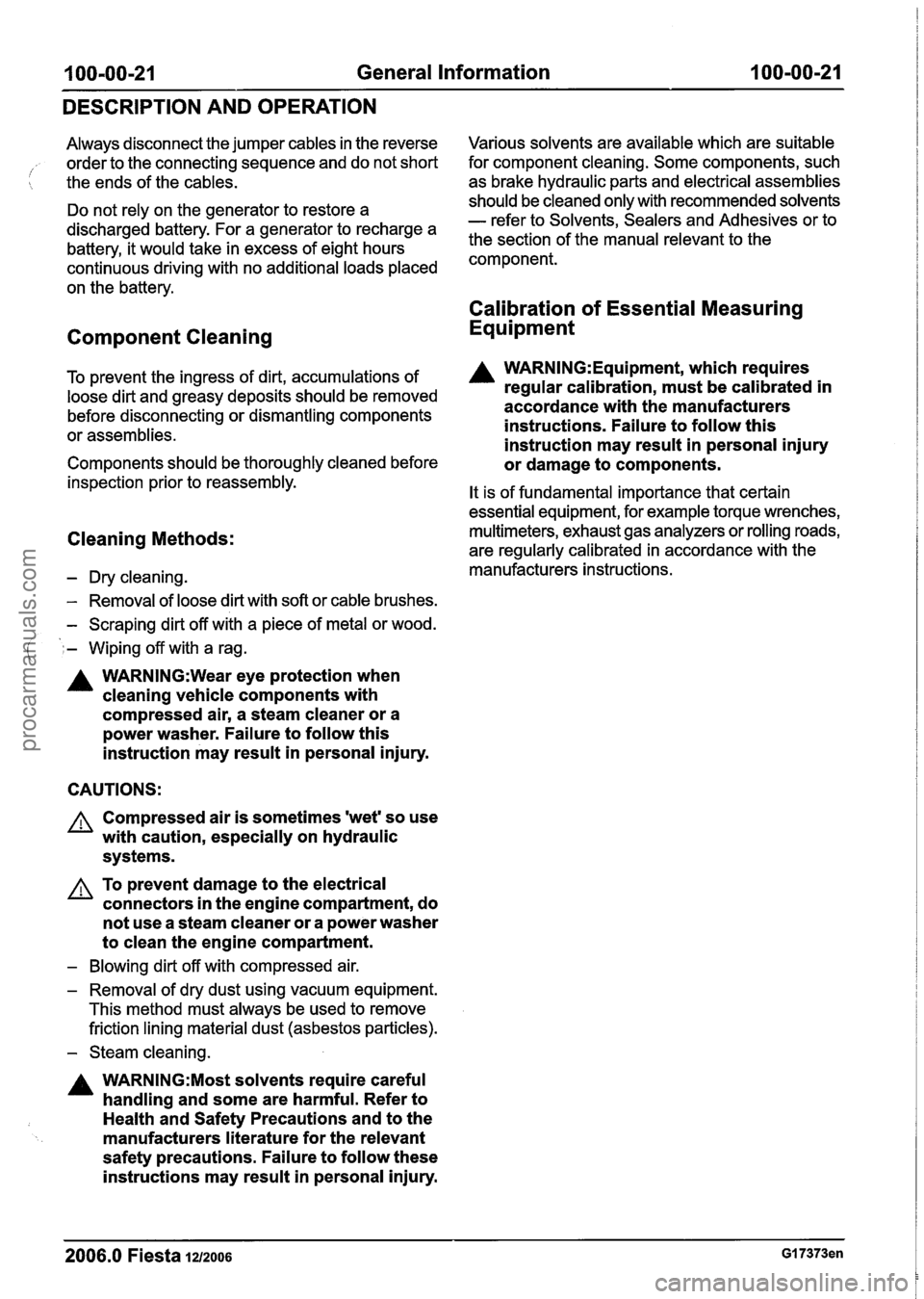
I 00-00-21 General Information 1 00-00-21
DESCRIPTION AND OPERATION
Always disconnect the jumper cables in the reverse
order to the connecting sequence and do not short
i the ends of the cables.
Do not rely on the generator to restore a
discharged battery. For a generator to recharge a
battery, it would take in excess of eight hours
continuous driving with no additional loads placed
on the battery.
Component Cleaning
To prevent the ingress of dirt, accumulations of
loose dirt and greasy deposits should be removed
before disconnecting or dismantling components
or assemblies.
Components should be thoroughly cleaned before inspection prior to reassembly.
Cleaning Methods:
- Dry cleaning.
- Removal of loose dirt with soft or cable brushes.
- Scraping dirt off with a piece of metal or wood.
( ,- Wiping off with a rag.
A WARN1NG:Wear eye protection when
cleaning vehicle components with
compressed air, a steam cleaner or a
power washer. Failure to follow this
instruction may result in personal injury.
CAUTIONS:
A Compressed air is sometimes 'wet' so use
with caution, especially on hydraulic
systems.
A To prevent damage to the electrical
connectors in the engine compartment, do
not use a steam cleaner or a power washer
to clean the engine compartment.
- Blowing dirt off with compressed air.
- Removal of dry dust using vacuum equipment.
This method must always be used to remove
friction lining material dust (asbestos particles).
- Steam cleaning.
A WARN1NG:Most solvents require careful
handling and some are harmful. Refer to
Health and Safety Precautions and to the
manufacturers literature for the relevant
safety precautions. Failure to follow these
instructions may result in personal injury.
Various solvents are available which are suitable
for component cleaning. Some components, such
as brake hydraulic parts and electrical assemblies
should be cleaned only with recommended solvents
- refer to Solvents, Sealers and Adhesives or to
the section of the manual relevant to the
component.
Calibration of Essential Measuring
Equipment
A WARNING:Equipment, which requires
regular calibration, must be calibrated in
accordance with the manufacturers
instructions. Failure to follow this
instruction may result in personal injury
or damage to components.
It is of fundamental importance that certain
essential equipment, for example torque wrenches,
multimeters, exhaust gas analyzers or rolling roads,
are regularly calibrated in accordance with the
manufacturers instructions.
2006.0 Fiesta 1212006 GI 7373en
procarmanuals.com
Page 52 of 1226
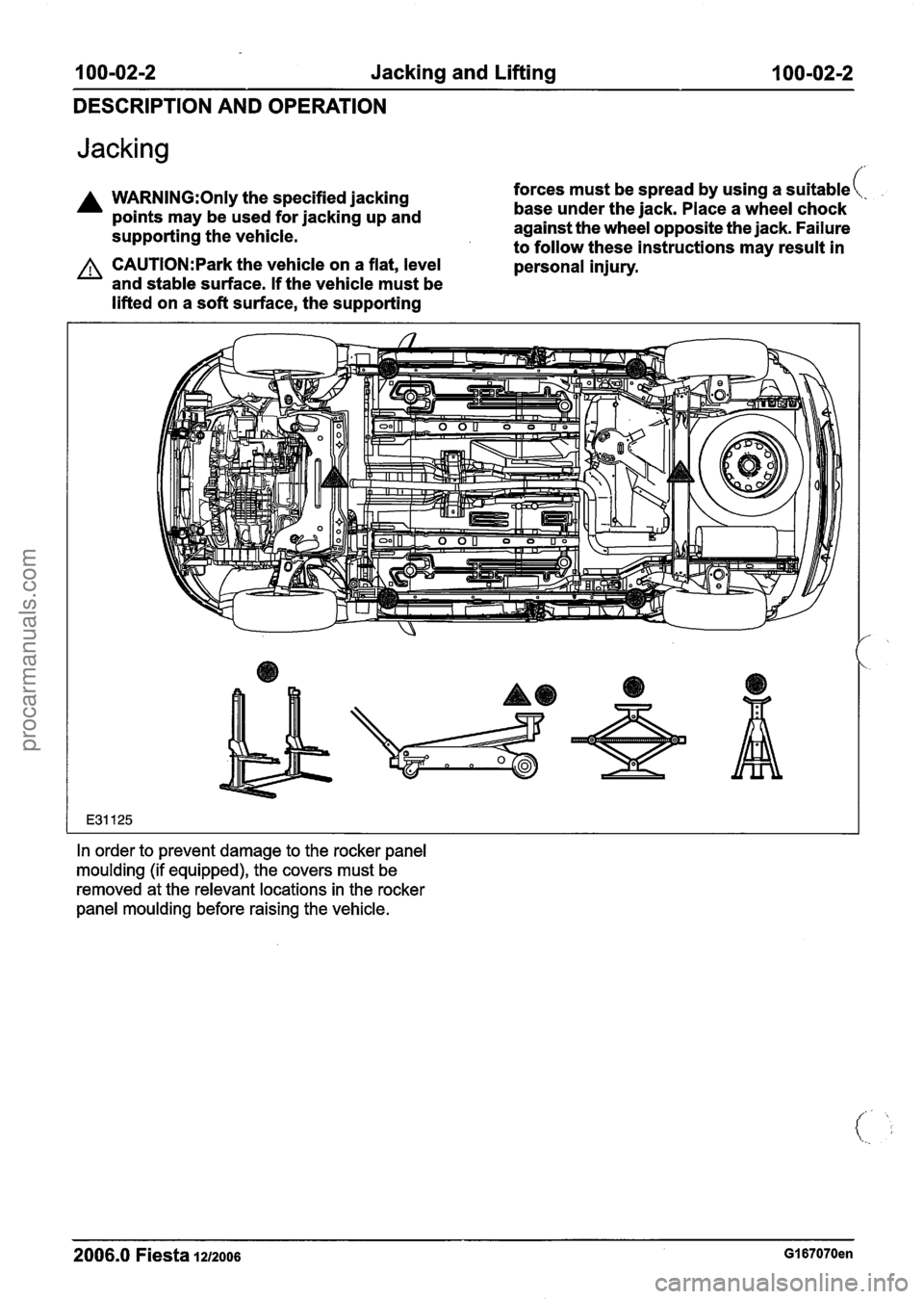
100-02-2 Jacking and Lifting 100-02-2
DESCRIPTION AND OPERATION
Jacking
A WARN1NG:Only the specified jacking
points may be used for jacking up and
supporting the vehicle.
A CAUTI0N:Park the vehicle on a flat, level
and stable surface. If the vehicle must be
lifted on a soft surface, the supporting forces
must be spread by using a suitable(:
base under the jack. Place a wheel chock
against the wheel opposite the jack. Failure
to follow these instructions may result in
personal injury.
In order to prevent damage to the rocker panel
moulding (if equipped), the covers must be
removed at the relevant locations in the rocker
panel moulding before raising the vehicle.
2006.0 Fiesta 1212006 GI 67070en
procarmanuals.com
Page 60 of 1226
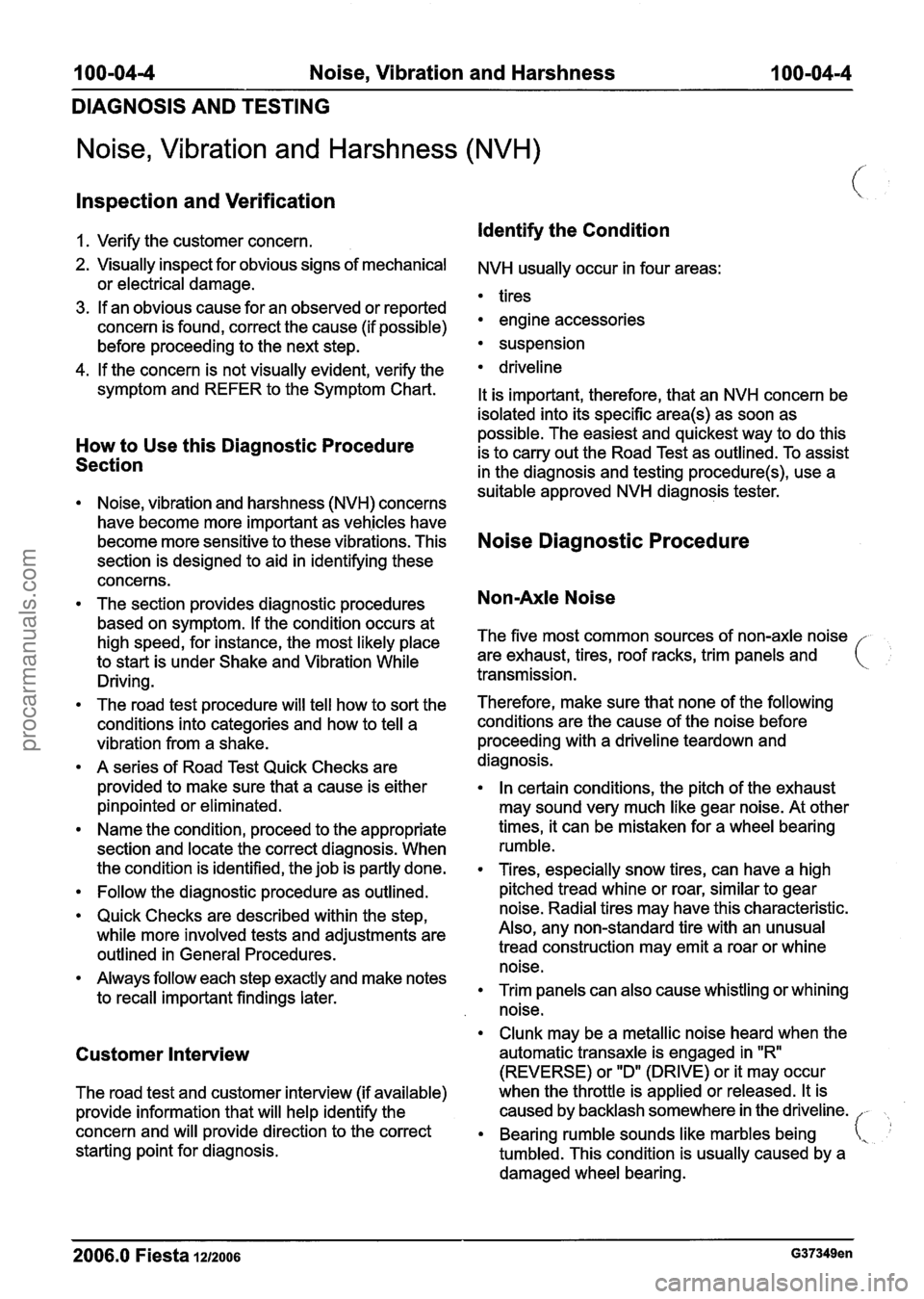
100-04-4 Noise, Vibration and Harshness 100-0414
DIAGNOSIS AND TESTING
Noise, Vibration and Harshness (NVH)
Inspection and Verification
1. Verify the customer concern. Identify the Condition
2. Visually inspect for obvious signs of mechanical NVH usually occur in four areas:
or electrical damage.
tires
3. If an obvious cause for an observed or reported
concern is found, correct the cause (if possible) engine accessories
before proceeding to the next step.
suspension
4. If the concern is not visually evident, verify the
symptom and REFER to the Symptom Chart.
How to Use this Diagnostic Procedure
Section
Noise, vibration and harshness (NVH) concerns
have become more important as
vehjcles have
become more sensitive to these vibrations. This
section is designed to aid in identifying these
concerns.
The section provides diagnostic procedures based on symptom. If the condition occurs at
high speed, for instance, the most likely place
to start is under Shake and Vibration While
Driving.
The road test procedure will tell how to sort the
conditions into categories and how to tell a
vibration from a shake.
A series of Road Test Quick Checks are
provided to make sure that a cause is either
pinpointed or eliminated.
Name the condition, proceed to the appropriate
section and locate the correct diagnosis. When
the condition is identified, the job is partly done.
Follow the diagnostic procedure as outlined.
Quick Checks are described within the step,
while more involved tests and adjustments are
outlined in General Procedures.
Always follow each step exactly and make notes
to recall important findings later.
driveline
It is important, therefore, that an NVH concern be
isolated into its specific
area(s) as soon as
possible. The easiest and quickest way to do this
is to carry out the Road Test as outlined. To assist
in the diagnosis and testing
procedure(s), use a
suitable approved NVH diagnosis tester.
Noise Diagnostic Procedure
Non-Axle Noise
The five most common sources of non-axle noise
are exhaust, tires, roof racks, trim panels and
( transmission.
Therefore, make sure that none of the following
conditions are the cause of the noise before
proceeding with a driveline
teardown and
diagnosis.
In certain conditions, the pitch of the exhaust
may sound very much like gear noise. At other
times, it can be mistaken for a wheel bearing
rumble.
Tires, especially snow tires, can have a high
pitched tread whine or roar, similar to gear
noise. Radial tires may have this characteristic.
Also, any non-standard tire with an unusual
tread construction may emit a roar or whine
noise.
Trim panels can also cause whistling or whining
noise.
Clunk may be a metallic noise heard when the
Customer Interview automatic transaxle is engaged in "R
(REVERSE) or "D" (DRIVE) or it may occur
The road test and customer interview (if available) when
the throttle is applied or released. It is
provide information that will help identify the caused
by backlash somewhere in the driveline.
,
concern and will provide direction to the correct Bearing rumble sounds like marbles being
starting point for diagnosis. (
tumbled. This condition is usually caused by a
damaged wheel bearing.
2006.0 Fiesta 1212006 G37349en
procarmanuals.com
Page 61 of 1226
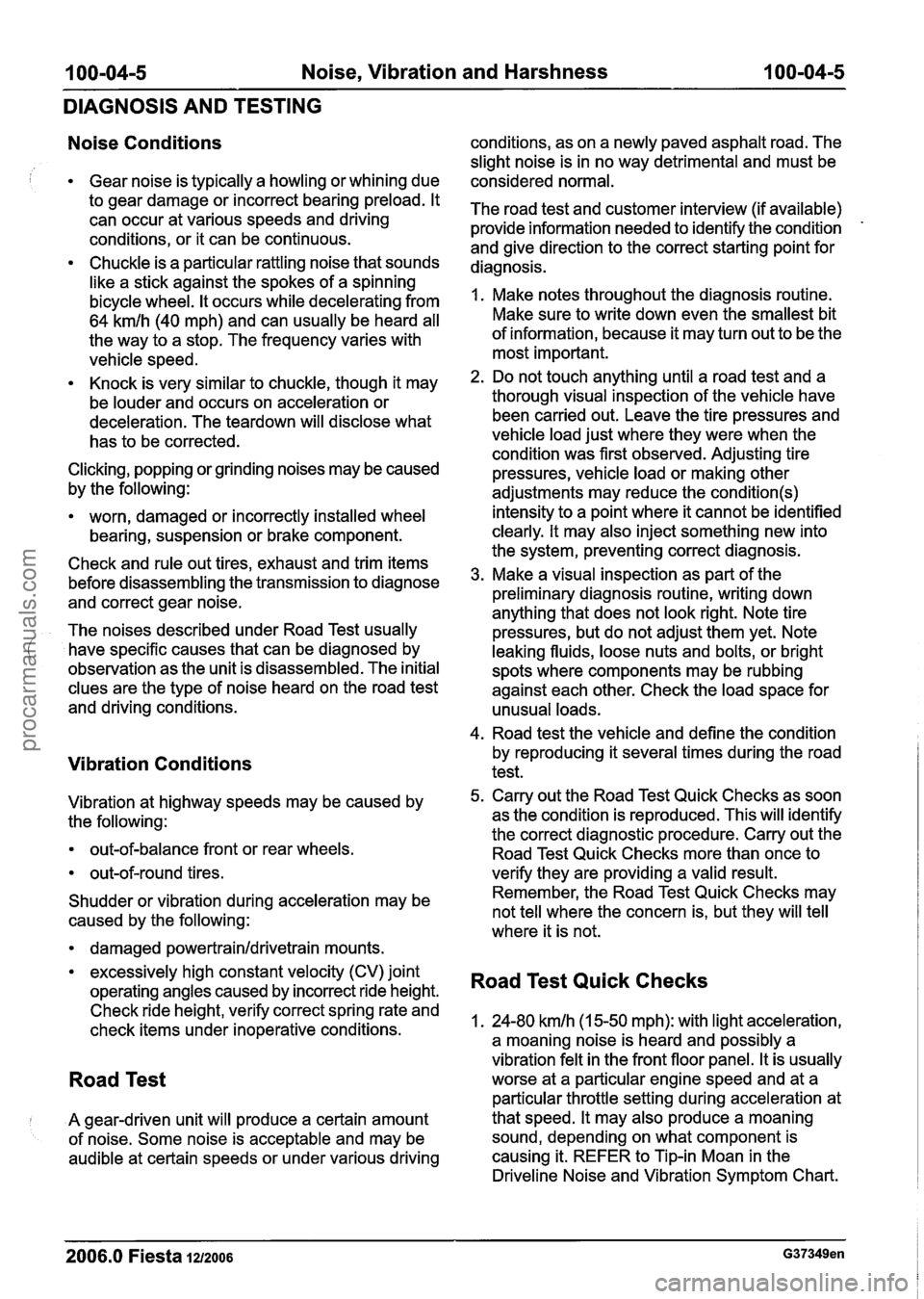
100-04-5 Noise, Vibration and Harshness 100-04-5
DIAGNOSIS AND TESTING
Noise Conditions
Gear noise is typically a howling or whining due
to gear damage or incorrect bearing preload. It
can occur at various speeds and driving
conditions, or it can be continuous.
Chuckle is a particular rattling noise that sounds
like a stick against the spokes of a spinning
bicycle wheel. It occurs while decelerating from
64
kmlh (40 mph) and can usually be heard all
the way to a stop. The frequency varies with
vehicle speed.
Knock is very similar to chuckle, though it may
be louder and occurs on acceleration or
deceleration. The
teardown will disclose what
has to be corrected.
Clicking, popping or grinding noises may be caused
by the following:
worn, damaged or incorrectly installed wheel
bearing, suspension or brake component.
Check and rule out tires, exhaust and trim items
before disassembling the transmission to diagnose
and correct gear noise.
The noises described under Road Test usually
( have specific causes that can be diagnosed by
observation as the unit is disassembled. The initial
clues are the type of noise heard on the road test
and driving conditions.
Vibration Conditions
Vibration at highway speeds may be caused by
the following:
out-of-balance front or rear wheels.
out-of-round tires.
Shudder or vibration during acceleration may be
caused by the following:
damaged powertrainldrivetrain mounts.
excessively high constant velocity (CV) joint
operating angles caused by incorrect ride height.
Check ride height, verify correct spring rate and
check items under inoperative conditions.
Road Test
I A gear-driven unit will produce a certain amount
of noise. Some noise is acceptable and may be
audible at certain speeds or under various driving conditions,
as on a newly paved asphalt road. The
slight noise is in no way detrimental and must be
considered normal.
The road test and customer interview (if available)
provide information needed to identify the condition
-
and give direction to the correct starting point for
diagnosis.
1. Make notes throughout the diagnosis routine.
Make sure to write down even the smallest bit
of information, because it may turn out to be the
most important.
2. Do not touch anything until a road test and a
thorough visual inspection of the vehicle have been carried out. Leave the tire pressures and
vehicle load just where they were when the
condition was first observed. Adjusting tire
pressures, vehicle load or making other
adjustments may reduce the
condition(s)
intensity to a point where it cannot be identified
clearly. It may also inject something new into
the system, preventing correct diagnosis.
3. Make a visual inspection as part of the
preliminary diagnosis routine, writing down
anything that does not look right. Note tire
pressures, but do not adjust them yet. Note
leaking fluids, loose nuts and bolts, or bright
spots where components may be rubbing
against each other. Check the load space for
unusual loads.
4. Road test the vehicle and define the condition
by reproducing it several times during the road
test.
5. Carry out the Road Test Quick Checks as soon
as the condition is reproduced. This will identify
the correct diagnostic procedure. Carry out the
Road Test Quick Checks more than once to
verify they are providing a valid result.
Remember, the Road Test Quick Checks may
not tell where the concern is, but they will tell
where it is not.
Road Test Quick Checks
1. 24-80 kmlh (1 5-50 mph): with light acceleration,
a moaning noise is heard and possibly a
vibration felt in the front floor panel. It is usually
worse at a particular engine speed and at a
particular throttle setting during acceleration at
that speed. It may also produce a moaning
sound, depending on what component is
causing it. REFER to Tip-in Moan in the
Driveline Noise and Vibration Symptom Chart.
2006.0 Fiesta 1212006 G37349en
procarmanuals.com
Page 62 of 1226
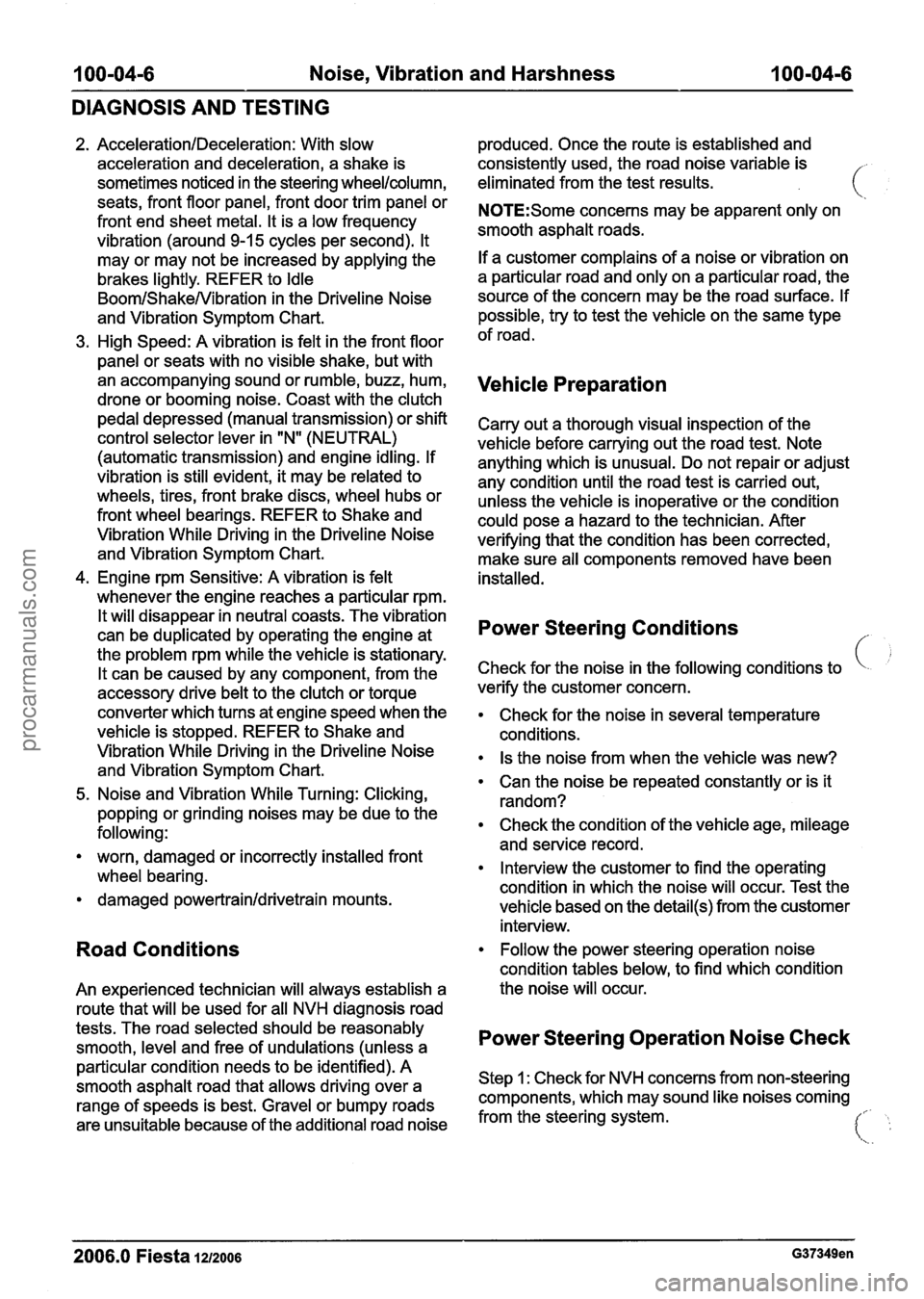
100-04-6 Noise, Vibration and Harshness 100-04-6
DIAGNOSIS AND TESTING
2. AccelerationIDeceleration: With slow
acceleration and deceleration, a shake is
sometimes noticed in the steering
wheellcolumn,
seats, front floor panel, front door trim panel or
front end sheet metal. It is a low frequency
vibration (around
9-1 5 cycles per second). It
may or may not be increased by applying the
brakes lightly. REFER to
Idle
BoomIShakeNibration in the Driveline Noise
and Vibration Symptom Chart.
High Speed: A vibration is felt in the front floor
panel or seats with no visible shake, but with
an accompanying sound or rumble, buzz, hum,
drone or booming noise. Coast with the clutch
pedal depressed (manual transmission) or shift
control selector lever in "N" (NEUTRAL)
(automatic transmission) and engine idling. If
vibration is still evident, it may be related to
wheels, tires, front brake discs, wheel hubs or
front wheel bearings. REFER to Shake and
Vibration While Driving in the Driveline Noise
and Vibration Symptom Chart.
4. Engine rpm Sensitive: A vibration is felt
whenever the engine reaches a particular rpm.
It will disappear in neutral coasts. The vibration
can be duplicated by operating the engine at
the problem rpm while the vehicle is stationary.
It can be caused by any component, from the
accessory drive belt to the clutch or torque
converter which turns at engine speed when the
vehicle is stopped. REFER to Shake and
Vibration While Driving in the Driveline Noise
and Vibration Symptom Chart.
5. Noise and Vibration While Turning: Clicking,
popping or grinding noises may be due to the
following:
worn, damaged or incorrectly installed front
wheel bearing.
damaged
powertrainldrivetrain mounts.
Road Conditions
An experienced technician will always establish a
route that will be used for all NVH diagnosis road
tests. The road selected should be reasonably
smooth, level and free of undulations (unless a
particular condition needs to be identified). A
smooth asphalt road that allows driving over a
range of speeds is best. Gravel or bumpy roads
are unsuitable because of the additional road noise produced.
Once the route is established and
consistently used, the road noise variable is
eliminated from the test results.
N0TE:Some concerns may be apparent only on
smooth asphalt roads.
If a customer complains of a noise or vibration on
a particular road and only on a particular road, the
source of the concern may be the road surface. If
possible, try to test the vehicle on the same type
of road.
Vehicle Preparation
Carry out a thorough visual inspection of the
vehicle before carrying out the road test. Note
anything which is unusual. Do not repair or adjust
any condition until the road test is carried out,
unless the vehicle is inoperative or the condition
could pose a hazard to the technician. After
verifying that the condition has been corrected,
make sure all components removed have been
installed.
Power Steering Conditions
c !
Check for the noise in the following conditions to
verify the customer concern.
Check for the noise in several temperature
conditions.
Is the noise from when the vehicle was new?
Can the noise be repeated constantly or is it
random?
Check the condition of the vehicle age, mileage
and service record.
Interview the customer to find the operating
condition in which the noise will occur. Test the
vehicle based on the
detail(s) from the customer
interview.
Follow the power steering operation noise
condition tables below, to find which condition
the noise will occur.
Power Steering Operation Noise Check
Step 1 : Check for NVH concerns from non-steering
components, which may sound like noises coming
from the steering system.
I:. ':
2006.0 Fiesta 121zoo6 G37349en
procarmanuals.com
Page 66 of 1226
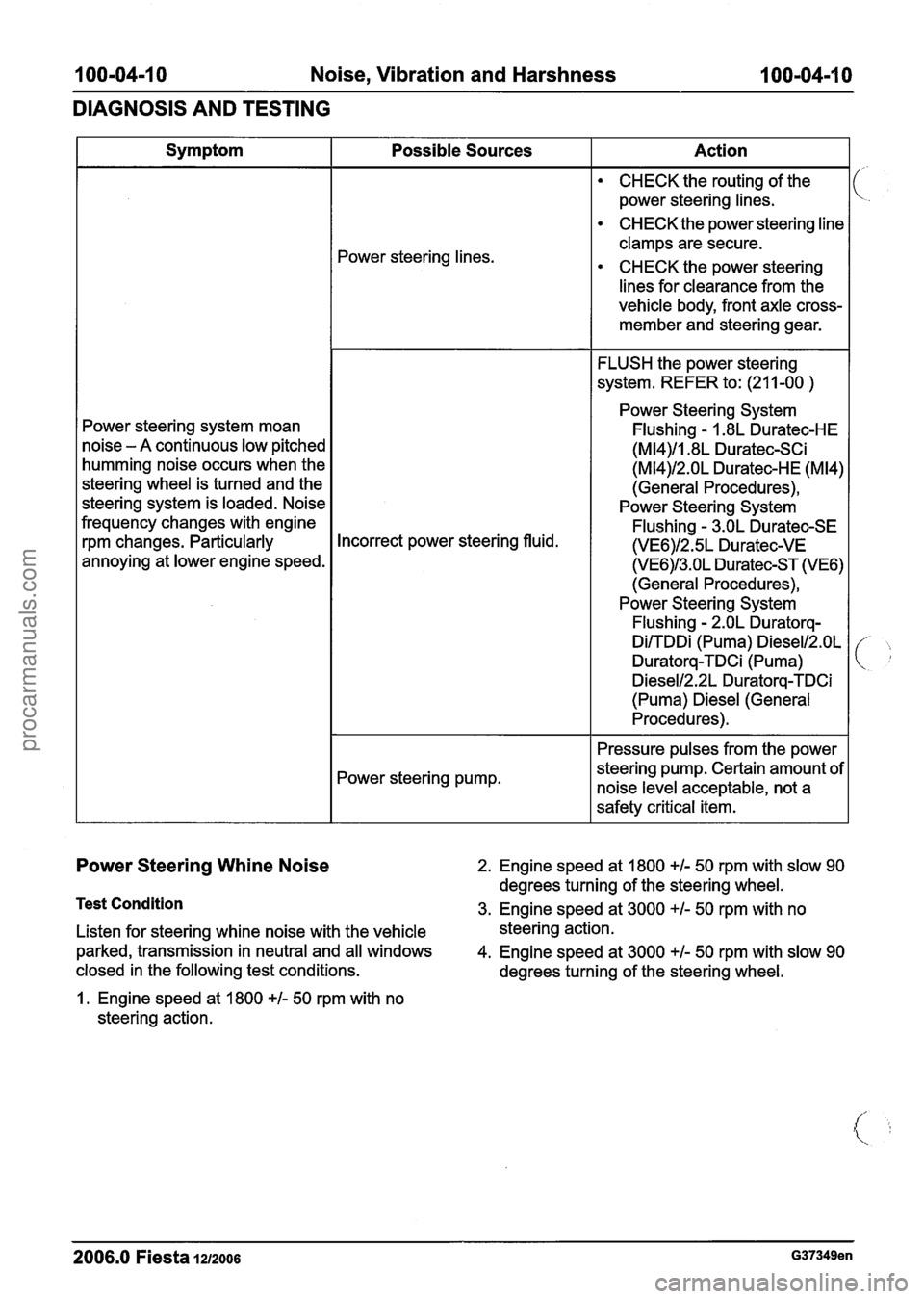
100-04-1 0 Noise, Vibration and Harshness 100-04-10
DIAGNOSIS AND TESTING
Power Steering Whine Noise 2. Engine speed at 1800 +/- 50 rpm with slow 90
degrees turning of the steering wheel.
Test Condition 3. Engine speed at 3000 +I- 50 rpm with no
Listen for steering whine noise with the vehicle steering action.
parked, transmission in neutral and all windows
4. Engine speed at 3000
+I- 50 rpm with slow 90
closed in the following test conditions. degrees turning of the steering wheel.
1. Engine speed at 1800
+I- 50 rpm with no
steering action. Symptom
Power steering system moan
noise
- A continuous low pitched
humming noise occurs when the
steering wheel is turned and the
steering system is loaded. Noise
frequency changes with engine
rpm changes. Particularly
annoying at lower engine speed.
2006.0 Fiesta 1212006 G37349en
Possible Sources
Power steering lines.
Incorrect power steering fluid.
Power steering pump. Action
CHECK
the routing of the
power steering lines.
CHECK the power steering line
clamps are secure.
CHECK the power steering
lines for clearance from the
vehicle body, front axle cross-
member and steering gear.
FLUSH the power steering
system. REFER to: (21 1-00
)
Power Steering System
Flushing
- I .8L Duratec-HE
(M14)/1.8L Duratec-SCi
(M14)/2.OL Duratec-HE (M14)
(General Procedures),
Power Steering System
Flushing
- 3.OL Duratec-SE
(VE6)/2.5L Duratec-VE
(VE6)/3.OL Duratec-ST (VE6)
(General Procedures),
Power Steering System
Flushing
- 2.OL Duratorq-
DirrDDi (Puma) Diesel12.0L
Duratorq-TDCi (Puma)
Diesell2.2L Duratorq-TDCi
(Puma) Diesel (General
Procedures).
Pressure pulses from the power
steering pump. Certain amount of
noise level acceptable, not a
safety critical item.
procarmanuals.com
Page 67 of 1226
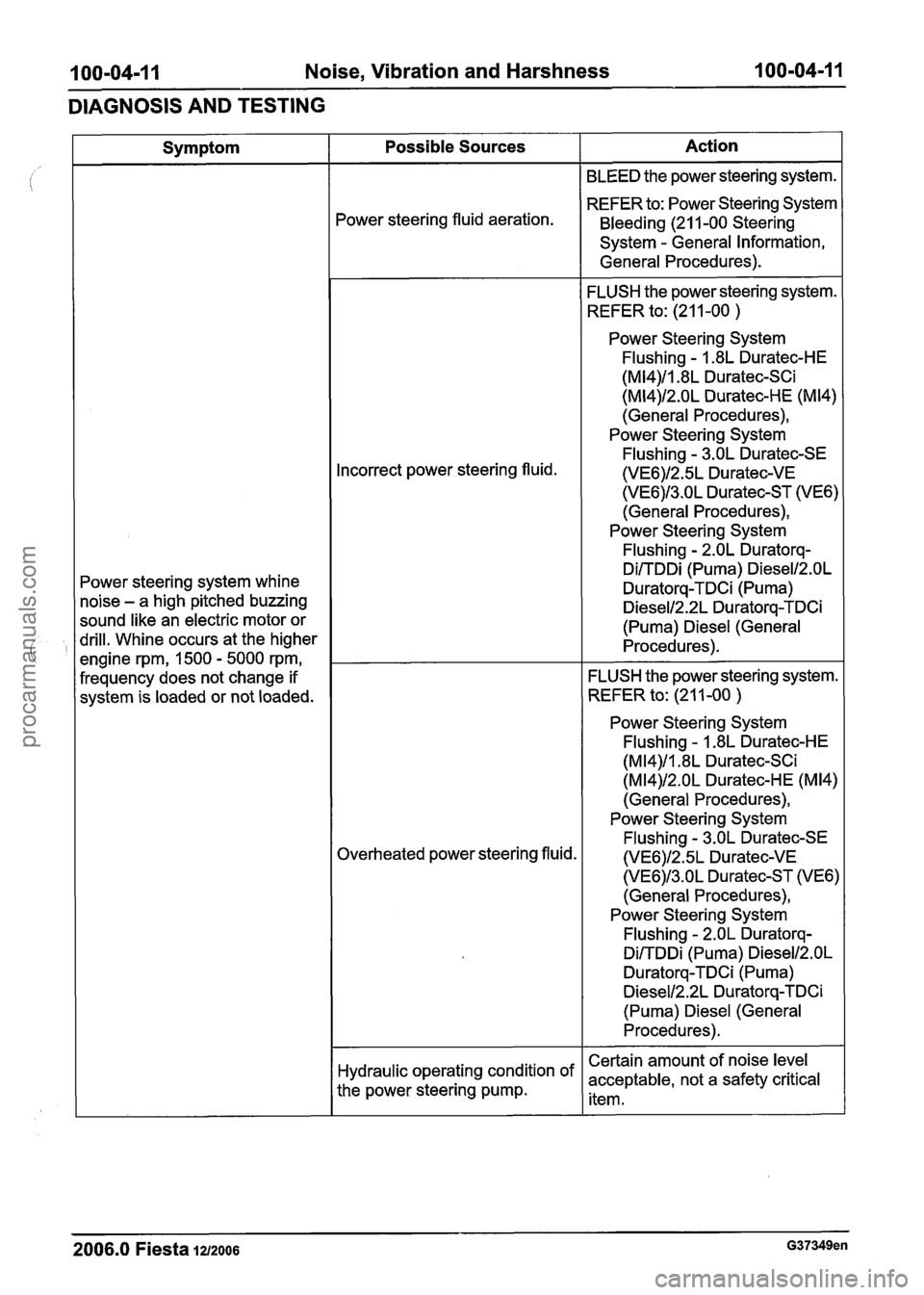
100-04-1 1 Noise, Vibration and Harshness 100=04=1 I
DIAGNOSIS AND TESTING
2006.0 Fiesta 1212006 G37349en
Symptom
Power steering system whine
noise
- a high pitched buzzing
sound like an electric motor or
drill. Whine occurs at the higher
engine rpm, 1500
- 5000 rpm,
frequency does not change if
system is loaded or not loaded.
Possible Sources
Power steering fluid aeration.
l ncorrect power steering fluid.
Overheated power steering fluid.
'perating condition of
the power steering pump.
Action
BLEED the power steering system.
REFER to: Power Steering System
Bleeding (21 1-00 Steering
System
- General Information,
General Procedures).
FLUSH the power steering system.
REFER
to: (21 1-00 )
Power Steering System
Flushing
- 1.8L Duratec-HE
(M14)/1.8L Duratec-SCi
(M14)/2.OL Duratec-HE (M14)
(General Procedures),
Power Steering System Flushing
- 3.OL Duratec-SE
(VE6)/2.5L Duratec-VE
(VE6)/3.OL Duratec-ST (VE6)
(General Procedures),
Power Steering System Flushing
- 2.OL Duratorq-
DilTDDi (Puma) Diesel12.0L
Duratorq-TDCi (Puma)
DieselI2.2L Duratorq-TDCi
(Puma) Diesel (General Procedures).
FLUSH the power steering system.
REFER to: (21 1-00
)
Power Steering System
Flushing
- 1.8L Duratec-HE
(M14)/1.8L Duratec-SCi
(M14)/2.OL Duratec-HE (M14)
(General Procedures),
Power Steering System Flushing
- 3.OL Duratec-SE
(VE6)/2.5L Duratec-VE
(VE6)/3.OL Duratec-ST (VE6)
(General Procedures),
Power Steering System Flushing
- 2.OL Duratorq-
DilTDDi (Puma) Diesel12.0L
Duratorq-TDCi (Puma)
Diesel12.2L Du ratorq-TDCi
(Puma) Diesel (General
Procedures).
Certain amount of noise level
acceptable, not a safety critical
item.
procarmanuals.com
Page 68 of 1226
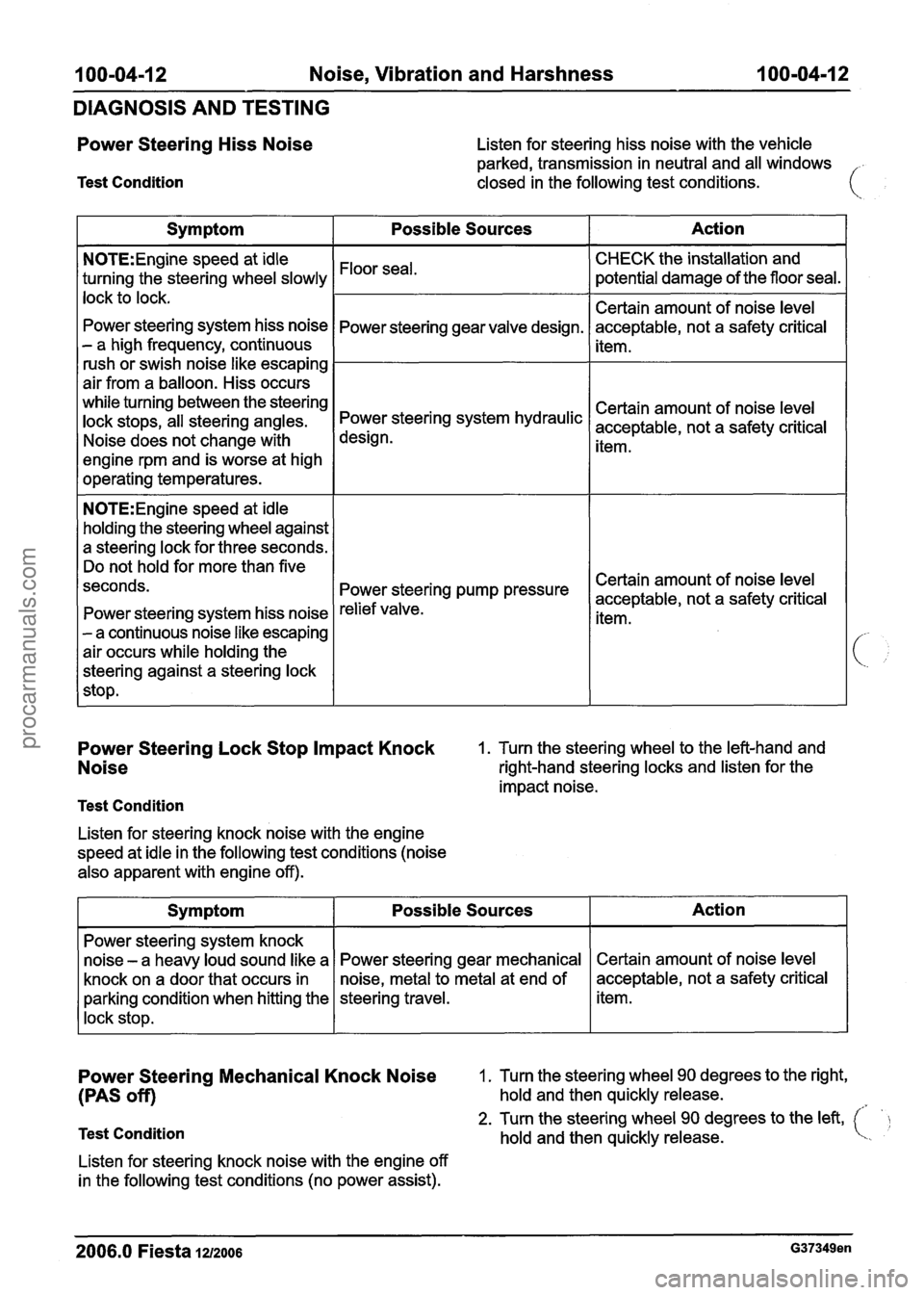
I 00-04-1 2 Noise, Vibration and Harshness I 00=04m12
DIAGNOSIS AND TESTING
Power Steering Hiss Noise
Test Condition
Listen for steering hiss noise with the vehicle
parked, transmission in neutral and all windows
-
closed in the following test conditions.
Power Steering Lock Stop Impact Knock 1. Turn the steering wheel to the left-hand and
Noise right-hand steering locks and listen for the
impact noise.
Test Condition
Listen for steering knock noise with the engine
speed at idle in the following test conditions (noise
also apparent with engine off).
Action
CHECK the installation and
potential damage of the floor seal.
Certain amount of noise level
acceptable, not a safety critical
item.
Certain amount of noise level
acceptable, not a safety critical
item.
Certain amount of noise level
acceptable, not a safety critical
item.
Symptom
N0TE:Engine speed at idle
turning the steering wheel slowly
lock to lock.
Power steering system hiss noise
- a high frequency, continuous
rush or swish noise like escaping
air from a balloon. Hiss occurs
while turning between the steering
lock stops, all steering angles.
Noise does not change with
engine rpm and is worse at high
operating temperatures.
N0TE:Engine speed at idle
holding the steering wheel against
a steering lock for three seconds.
Do not hold for more than five
seconds.
Power steering system hiss noise
- a continuous noise like escaping
air occurs while holding the
steering against a steering lock
stop.
Possible Sources
Floor seal.
Power steering gear valve design.
Power steering system hydraulic
design.
Power pump pressure
relief valve.
Power Steering Mechanical Knock Noise 1. Turn the steering wheel 90 degrees to the right,
(PAS off) hold and then quickly release.
2. Turn the steering wheel 90 degrees to the left, Test Condition hold and then quickly release.
Listen for steering knock noise with the engine off
in the following test conditions (no power assist).
2006.0 Fiesta 1212006 G37349en
Action
Certain amount of noise level
acceptable, not a safety critical
item.
Symptom
Power steering system knock
noise
- a heavy loud sound like a
knock on a door that occurs in
parking condition when hitting the
lock stop.
Possible Sources
Power steering gear mechanical
noise, metal to metal at end of
steering travel.
procarmanuals.com
Page 69 of 1226
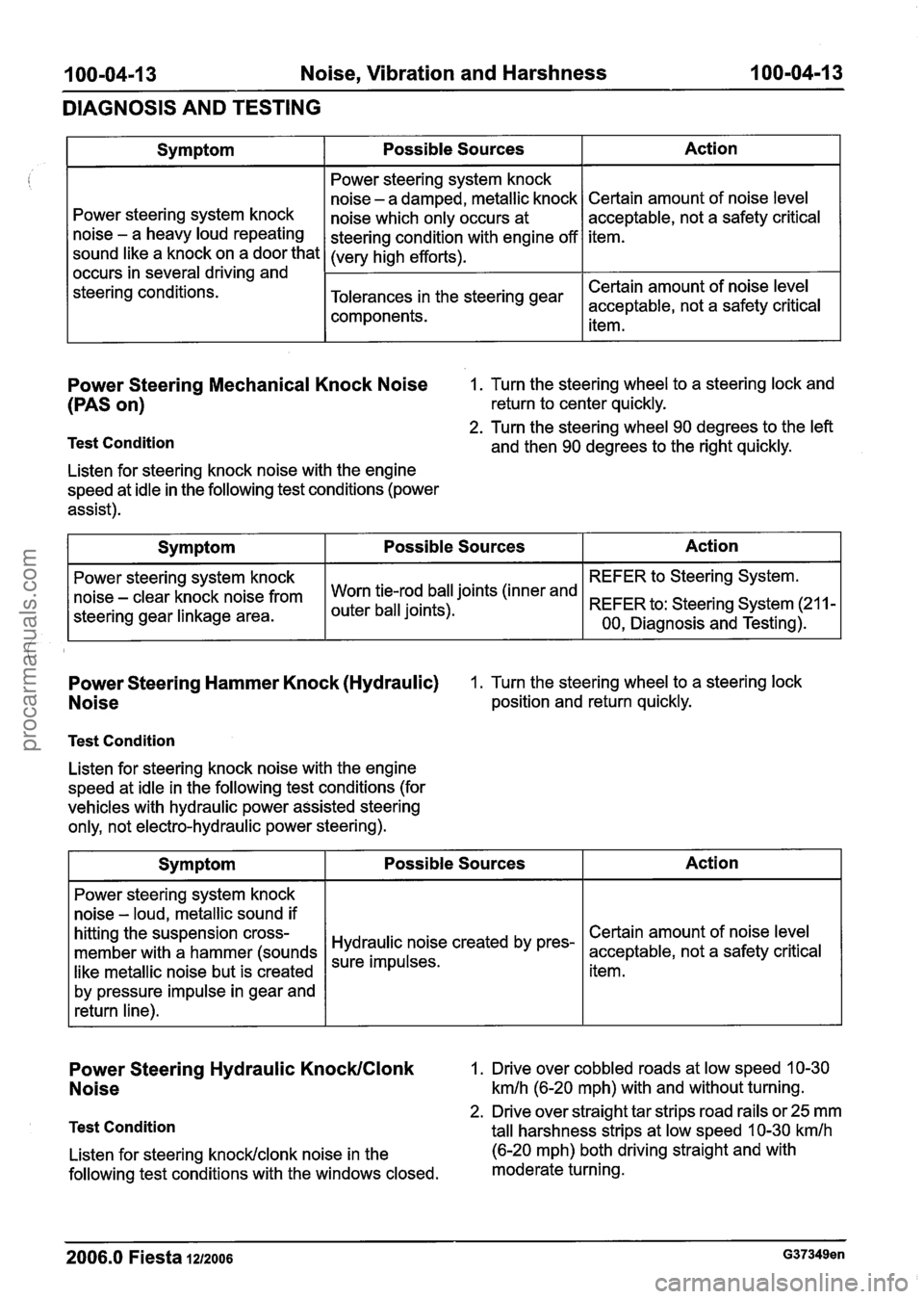
100-04-13 Noise, Vibration and Harshness 100-04-13
DIAGNOSIS AND TESTING
Power Steering Mechanical Knock Noise 1. Turn the steering wheel to a steering lock and
(PAS on) return to center quickly.
2. Turn the steering wheel 90 degrees to the left
Test Condition and then 90 degrees to the right quickly.
Listen for steering knock noise with the engine
speed at idle in the following test conditions (power
assist).
Action
Certain amount of noise level
acceptable, not a safety critical
item.
Certain amount of noise level
acceptable, not a safety critical
item.
Symptom
Power steering system knock
noise - a heavy loud repeating
sound like a knock on a door that
occurs in several driving and
steering conditions.
Power Steering Hammer Knock (Hydraulic) 1. Turn the steering wheel to a steering lock
Noise position and return quickly.
Possible Sources
Power steering system knock
noise
- a damped, metallic knock
noise which only occurs at
steering condition with engine off
(very high efforts),
Tolerances in the steering gear
components.
Test Condition
Action
REFER to Steering System.
REFER to: Steering System (21
1 -
00, Diagnosis and Testing).
Symptom
Power steering system knock
noise - clear knock noise from
steering gear linkage area.
Listen for steering knock noise with the engine
speed at idle in the following test conditions (for
vehicles with hydraulic power assisted steering only, not electro-hydraulic power steering).
Possible Sources
Worn tie-rod ball joints (inner and
outer ball joints).
Symptom Possible Sources Action
hitting the suspension cross- Certain
amount of noise level
by pressure impulse in gear and
return line).
Power Steering Hydraulic KnocWClonk 1. Drive over cobbled roads at low speed 10-30
Noise kmlh (6-20 mph) with and without turning.
2. Drive over straight tar strips road rails or 25 mm
Test Condition tall harshness strips at low speed 10-30 kmlh
Listen for steering knocklclonk noise in the (6-20
mph) both driving straight and with
following test conditions with the windows closed. moderate turning.
2006.0 Fiesta 1212006 G37349en
procarmanuals.com
Page 70 of 1226
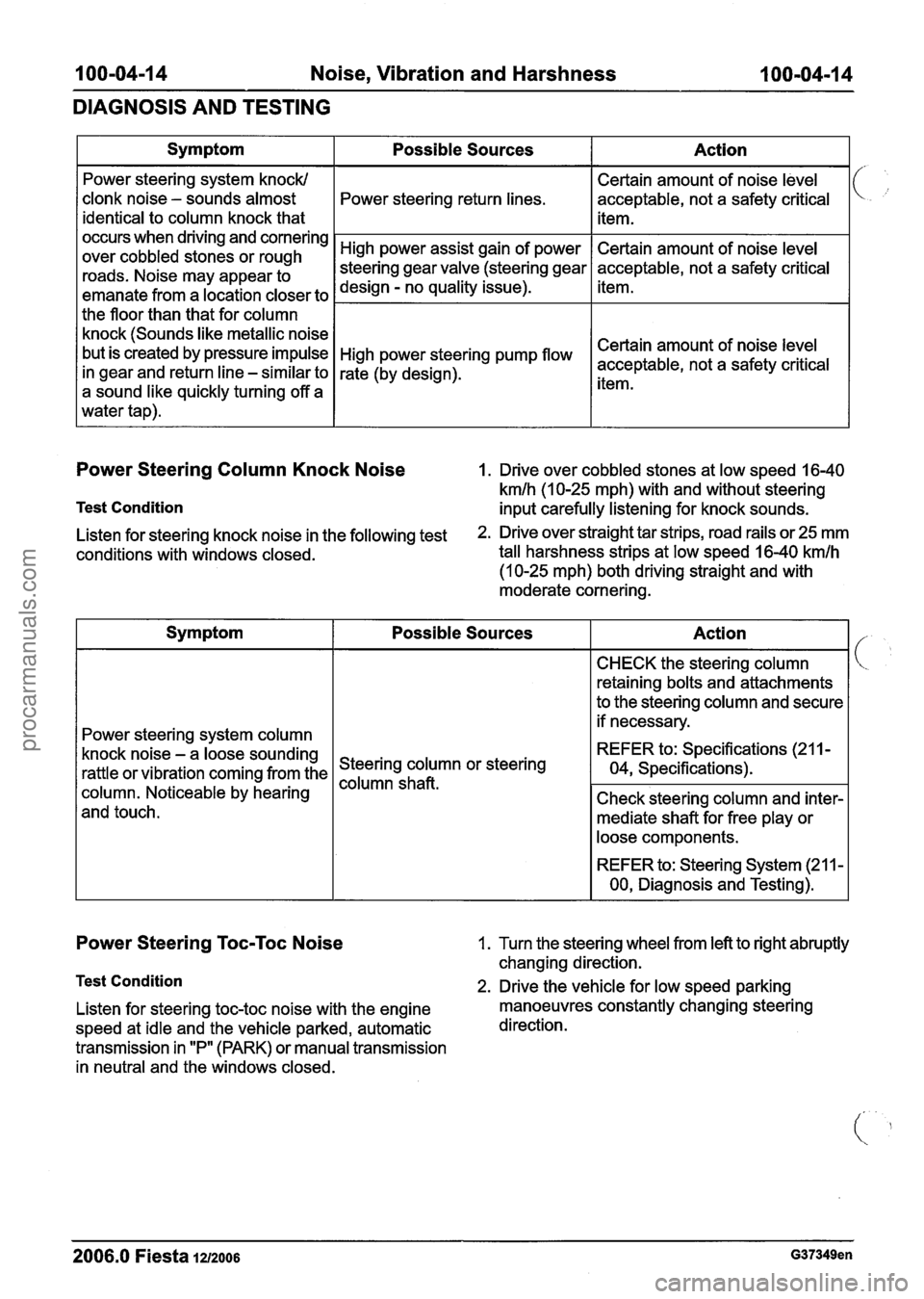
100-04-14 Noise, Vibration and Harshness 100-04-14
DIAGNOSIS AND TESTING
Power Steering Column Knock Noise I. Drive over cobbled stones at low speed 16-40
kmlh (1 0-25 mph) with and without steering
Test Condition input carefully listening for knock sounds.
Symptom
Power steering system knock1
clonk noise - sounds almost
identical to column knock that
occurs when driving and cornering
over cobbled stones or rough
roads. Noise may appear to
emanate from a location closer to
the floor than that for column
knock (Sounds like metallic noise
but is created by pressure impulse
in gear and return line
- similar to
a sound like quickly turning off a
water tap).
Listen for steering knock noise in the following test 2. Drive over straight tar strips, road rails or 25 mm
conditions with windows closed. tall
harshness strips at low speed 16-40
kmlh
(10-25 mph) both driving straight and with
moderate cornering.
Possible Sources
Power steering return lines.
High power assist gain of power
steering gear valve (steering gear
design
- no quality issue).
High power steering pump
flow
rate (by design).
Power Steering Toc-Toc Noise 1. Turn the steering wheel from left to right abruptly
changing direction.
Test Condition 2. Drive the vehicle for low speed parking
Listen for steering
toc-toc noise with the engine manoeuvres constantly changing steering
speed at idle and the vehicle parked, automatic direction.
transmission in "P" (PARK) or manual transmission
in neutral and the windows closed.
Action
Certain amount of noise level
acceptable, not a safety critical
item.
Certain amount of noise level
acceptable, not a safety critical
item.
Certain amount of noise level
acceptable, not a safety critical
item.
Symptom
Power steering system column
knock noise
- a loose sounding
rattle or vibration coming from the
column. Noticeable by hearing
and touch.
2006.0 Fiesta 1212006 G37349en
Possible Sources
Steering column or steering
column
Action
CHECK the steering column
retaining bolts and attachments
to the steering column and secure
if necessary.
REFER to: Specifications (21 1
-
04, Specifications).
Check steering column and inter- mediate shaft for free play or
loose components.
REFER to: Steering System (2 11
-
00, Diagnosis and Testing).
procarmanuals.com